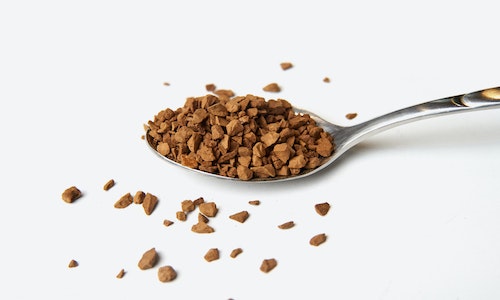So you’ve woken up and walked over to your kitchen to make your first cup of joe using your favorite instant coffee, only to find mold growing in it. So what are you to do? Is it still safe to drink or do you need to throw it away?
It is not safe to drink instant coffee that has mold growing on it, so if found even in small quantities, the remaining coffee should be discarded. Molds can produce toxic compounds called mycotoxins which are known to cause serious health complaints when ingested, some of which are long-lasting.
In this article, I’ll be covering the topic of mold in instant coffee, and whether drinking it is still safe, so keep reading!

Related articles
Moldy Coffee And Mycotoxins: Do You Need To Worry?
Is it safe to drink moldy instant coffee?
It is certainly not safe to drink instant coffee if you have found mold growing in it. You may think that if boiling water is added to the granules this will make it safe to consume, but this is not the case.
Whilst the temperature of the water may kill bacteria and many mold strains, mycotoxins (toxic compounds molds create as a defense mechanism) can withstand high temperatures , so many will remain intact after coming into contact with the water and can still cause you serious harm if ingested.
, so many will remain intact after coming into contact with the water and can still cause you serious harm if ingested.
The mold and bacteria are not the only issues here though, growth of any kind shows signs of spoilage of the product, meaning that if you were to drink this coffee, there’s a very good chance it could make you quite ill.
The taste and smell will also be heavily impacted by spoilage of any kind, so it really isn’t something you are going to want to be doing.
Is the mold growing in your instant coffee dangerous?
Without having the mold tested, there is no surefire way of knowing exactly which strain you are dealing with, however, even in healthy individuals, coming into regular contact with mold in coffee powder can cause serious negative health effects .
.
Molds can become hazardous to humans and animals when they produce metabolites called mycotoxins. These are produced as a defense mechanism whenever a mold feels threatened, and if these are ingested or inhaled in large quantities or over a prolonged period, they can produce symptoms ranging from mild to severe.
Some of the most common symptoms of mycotoxin exposure are the following:
- Nausea
- Headaches
- Gastrointestinal discomfort
- Vomiting
In rare circumstances, (such as with those with suppressed immune systems), symptoms could include liver and kidney damage and cancer.
For these reasons, it is always advised to throw away instant coffee powder or granules that have mold. And if you have already had a cup or two and then noticed the presence of mold, you may well be fine as no more is ingested. If you do feel any of the symptoms mentioned, you should consult a physician.
What if you accidentally drank instant coffee that had mold in it?
So, say you’ve somehow managed to drink half your cup of coffee, set it down, and noticed that there are chunks of what looks like white mold floating around in it. What are you supposed to do now?
Well, the good news is that in the vast majority of cases, unless you are severely allergic to mold and its spores, you are unlikely to suffer any serious consequences . There is of course the possibility that you may have an upset stomach, but this is not guaranteed and can depend on how much of the mold you ingested.
. There is of course the possibility that you may have an upset stomach, but this is not guaranteed and can depend on how much of the mold you ingested.
It goes without saying that you should stop drinking coffee as soon as you notice anything floating in it (even if it’s not mold). It’s not a good idea to try to make yourself vomit, as if you have swallowed mycotoxins, this could cause injury and may not be effective at removing mycotoxins anyway.
If you start to have any unusual symptoms, you should contact your healthcare provider to ask for advice, but again, in most cases, you will probably be fine. Monitor for a few days and seek medical advice if you feel anything out of the ordinary just to be on the safe side.
What if you can’t see any mold, but your coffee smells musty?
Not all mold is visible, in fact, newly formed growth can be so minute that it cannot be seen. It is for this reason that if you open a jar of instant coffee, you smell a strong musty odor instead of the pleasant aroma you would expect, it is not worth the risk to consume the coffee, as it could still make you very ill.
instead of the pleasant aroma you would expect, it is not worth the risk to consume the coffee, as it could still make you very ill.
There is also the possibility that the mold has grown and then been shaken down deeper into the granules during transit, making it difficult to spot. This again is where your sense of smell would come in, as you might not be able to spot the growth, but you almost certainly smell it.
If this is the case, you should once again discard the jar and purchase another, as it is simply not worth taking the risk.
Can moldy instant coffee be saved?
You may have heard of people scrapping mold off the top of food items and eating whatever is left.
This is NOT a good idea, especially with instant coffee.
Should you find mold growing on top of your instant coffee powder or granules, you should throw it out and not consume it at all.
The reason for this is that even if you were to scrape off the top layer, you may be pushing some of the molds deeper into the jar, and you may also be disturbing the mold’s spores, which will then settle, further contaminating the jar.
There is no safe way of removing mold from instant coffee, so should you find it, you are better off cutting your losses and tossing it out, rather than running the risk of becoming ill.
How to safely discard moldy instant coffee
As we have discussed, fungal growth in instant coffee grounds can cause serious health complaints if ingested, but the mycotoxins can also be very damaging if inhaled. It is for this reason that once you have discovered contaminated granules, you discard them safely to prevent anyone from becoming ill.
The following is a step-by-step process to safely throw away moldy coffee granules.
- Close the lid of the container the coffee came in
- Place it in a plastic bag and tie it securely to prevent any spores from being released
- Put the bag with the container in it in the trash bag gently to avoid tearing the bag
- Wash your hands and clean any surfaces that may have come into contact with spores when the container was opened
How to prevent mold growth in instant coffee
Cross-contamination is one of the biggest causes of mold growth in jars of opened instant coffee. Simply putting a wet spoon into a dry jar of granules is all it takes to give mold exactly what it needs in order to live on your delicious coffee.
That being the case, in order to prevent mold from growing on your instant coffee, all you need to do is take away what it needs to live, which are :
:
- A source of moisture
- Nutrients
- An ambient temperature between 60-80 degrees Fahrenheit
The nutrients come from the coffee itself, so you can’t do much to remove that, and you will most likely be storing the jar in a cupboard at an ambient temperature, which leaves moisture as the number one factor that you can directly influence.
Without moisture, mold will not be able to live, so keeping your granules as dry as possible will keep them fresh and mold-free.
Here are a few tips to keep your instant coffee free of mold:
- Never use a wet spoon to scoop up coffee granules
- Store the jar or tin away from the higher humidity areas of the kitchen
- Keep the granules in an air-tight container at all times
What is the White stuff in your instant coffee?
The white powdery substance you’ve seen on the surface of your instant coffee is almost certainly an example of fungus on coffee powder. Specifically, it is most likely to be one of three, Cladosporium, Aspergillus, or Penicillium.
As well as being white in color, these strains can also come in greyish or blueish shades, and may even change to green or black over time.
These strains of molds have textures most commonly described as being “powdery”, “velvety” and in some cases, even “slimy”.
There is the possibility that additives within the granules have spoiled and have created a white powdery substance, but this is fairly uncommon, so the most likely cause is mold growth.
Are there mold-free instant coffee powders?
There are several brands of instant coffee available that claim to be “mold-free”. What this really refers to is the level of mold found within the bean whilst it was grown, processed, shipped, and stored.
Instant coffee that is “mold-free”, does not mean it cannot become contaminated once it arrives at your home and you open the packet or tin.
Should you get the coffee powder or granules wet, they are just as likely to become moldy as any other coffee product.
Conclusion
You should never risk drinking instant coffee that has mold on it, as it has the potential to make you seriously ill. If you find that the coffee you have purchased has mold growth or smells musty or “off” in any way, it should be discarded safely. Whilst accidentally ingesting a small amount of moldy instant coffee may not cause immediate harm, it should always be avoided if possible.
Over to you
I hope this article has helped you understand a little more about the dangers of drinking moldy coffee, but now I’d like to turn it over to you, was there anything you think was missing from the article that you’d like me to answer? Have you ever suffered from consequences after drinking a moldy cup of brew in the morning? Or do you have any general questions about the topic? If you do, please leave a comment below and I’ll get back to you.

